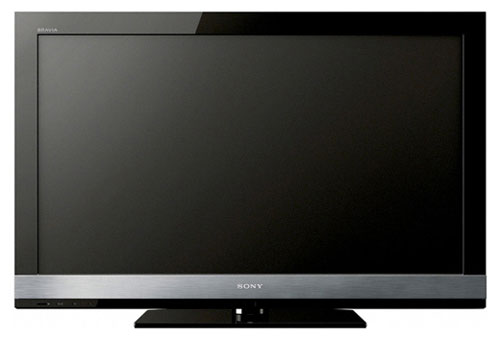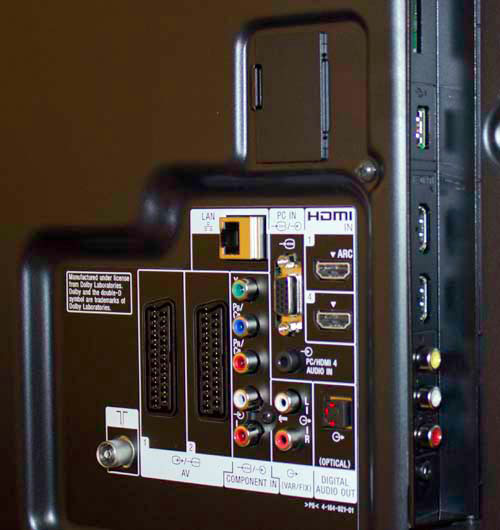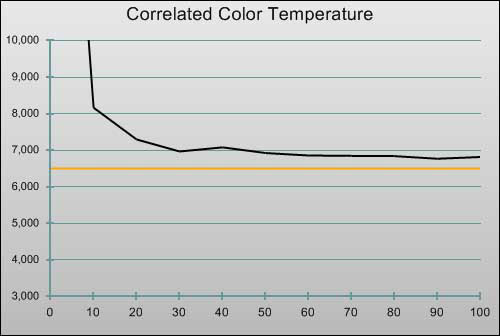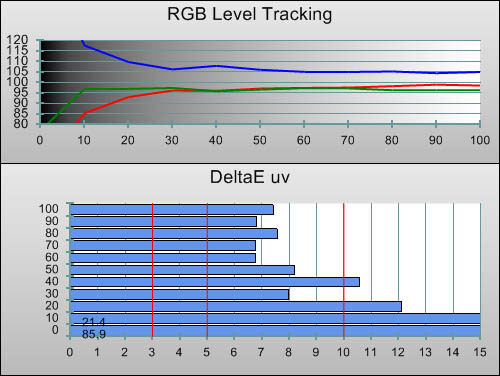Like it or lump it, consumers’ apparent love for slim LED-sidelit LCD televisions probably isn’t going to go away any time soon. Samsung have aggressively pushed the concept, and so far we’ve seen other manufacturers introducing their own sidelit products to claim their share of the profits. The KDL40EX703 is the first LED sidelit LCD HDTV we’ve reviewed from Sony, who have lately been producing some nice (albeit slightly overpriced) displays. As well as the slim design, the second most notable attribute on the Sony KDL40EX703 is probably the power-saving Presence Sensor, which promises to save power by shutting off the LCD panel when nobody’s in the room to watch it.
<!-- google_ad_client = 'pub-2887677957235196'; google_ad_slot = '4990177225'; google_ad_width = 336; google_ad_height = 280; //-->
The KDL40EX703 is also the first Sony-branded HDTV we’ve reviewed that uses a Sharp UV2A panel, rather than the Super PVA type which Sony has been manufacturing with Samsung for half a decade now. It’ll be interesting to see if Sony’s new business partners can meet or exceed the generally high quality images that are characteristic of SPVA panels, while at the same time, keeping the chassis slim. Let’s see how the Sony KDL40EX703 stacks up!
Note: The specific model we tested was the Sony KDL40EX703U, i.e. the 3-pin-plug United Kingdom version. The terms Sony KDL40EX703 and Sony KDL40EX703U will be used interchangeably throughout this article to refer to the same LED LCD TV.
The Sony KDL40EX703 betrays its slim design by featuring a somewhat thick, gloss-black bezel around the screen. We’ll be curious to hear what other users think (the comments section is below!), but we psychologically associate the thick, sharp-edged, almost slab-like gloss black borders with large, heavy displays. In reality, the Sony KDL40EX703U is neither.

The bottom part of the Sony KDL40EX703 is another story though: it has a “brushed steel” look (although touching it suggests that it’s plastic, the eye typically can’t tell the difference). The stand shares the somewhat cheap-looking gloss black finish as most of the TV’s bezel. Finally, the build quality is much better than cheaper Sony televisions: everything feels locked tightly in place.
The Sony KDL40EX703U features 4 HDMI inputs in total, which are divided equally between the back panel and the recessed side panel. There’s also Component video inputs, an analogue RGB “VGA” input for PCs, 2 SCART terminals, a LAN port for internet/network connectivity, and also the RF aerial input which feeds the built-in PAL/DVB-T/DVB-T2 tuner and allows our UK readers to receive Freeview HD.
As well as featuring 2 of the 4 HDMI inputs, the side panel features a USB input, the Common Interface slot, and Composite Video/Stereo Audio inputs. There’s also a headphone output here.
 |
| Rear: 2 x HDMI, VGA, component, 2 x Scarts, aerial, ethernet & audio outs Side: Common Interface, USB, 2 x HDMI, Composite video, headphone socket |
Like all of the Sony models we’ve reviewed recently, the KDL40EX703 features the Xross Media Bar menu system (it’s pronounced “Cross”). In previous reviews, we’ve usually said that the menu interface is usable enough, but not preferable to traditional top-to-bottom designs. We’ve finally been able to verbalise exactly why this is: most manufacturers place the most critical options (Picture settings) near the top, with extra “added value” features at the bottom of the menu stack. With the XMB menu, Sony places the Picture controls at the far left, but the default “starting position” is always on the far right, meaning that users have to scroll through columns they may have no interest whatsoever in, in order to reach the important controls. Couple that with the fact that the XMB is sightly slower to react than more basic menus, and well, you get the idea. It’s a minor point, but we’re sure UI design experts would attest to the idea that every little detail counts.
The [Settings] column houses the [Picture] and [Screen] categories, which contain many of the adjustments we’ll be adjusting to wring the best image quality out of the Sony KDL40EX703U LED LCD. All of the controls here are in good working order, including the more Sony-specific entries: [Motionflow], which lets the user choose from two levels of motion interpolation strength, and [Film Mode], which is more than just a film deinterlacing switch, as we’ll find out later.
![[Picture] menu](https://www.hdtvtest.co.uk/news/wp-content/uploads/2018/04/hdtv_Sony-KDL40EX703_picture.jpg) | ![[White Balance] menu](https://www.hdtvtest.co.uk/news/wp-content/uploads/2018/04/hdtv_Sony-KDL40EX703_wb.jpg) |
| [Picture] menu | [White Balance] menu |
The [Advanced Settings] screen is, like previous Sony displays, mostly redundant. There’s a “Gamma” control which may prove useful in getting the most accurate distribution of dark-to-light from the Sony KDL40EX703, and the [White Balance] screen, which houses the controls we need to calibrate Greyscale. There are still no colour calibration controls, but interestingly, the [Live Colour] control appears to have been implemented slightly differently on the Sony KDL40EX703U. On previous Sony TVs, this has simply over-cooked Luminance levels, effectively doing the same thing as simply turning up the TV’s basic [Colour] control. On the Sony KDL40EX703, the three different “on” settings (Low, Medium, and High) each produce slightly different hues, rather than only exaggerating the colours. Most noticeably, “Medium” pushes the colour of Yellow closer to Red. It’s likely that the control is still a gimmick, but we’ll find out if there’s any use for it during calibration.
One other point to note is that the KDL40EX703U uses Sony’s “Scene Mode” menu, which lets the user choose from different video/audio setting combinations, such as “Sports”, “Music”, “Cinema”, and “Game”. Since we will be calibrating for picture accuracy, we’ll have no use for jumping between different modes (except for “Game” mode, which should be useful in cutting down video processor delay with games consoles). We put the Sony KDL40EX703 into “Cinema” mode and left it this way at all times during the review, except for when testing Gaming performance.
Note: Our Sony KDL40EX703U review sample was calibrated using Calman Professional, the industry-leading video calibration software.
Without any further adjustments made beyond selecting the “Cinema” mode, the Sony KDL40EX703’s Greyscale quality was passable, but the excess of blue in the image was just about visible to the trained eye.
 |
| Pre-calibration CCT in [Cinema] mode |
 |
| Pre-calibration RGB tracking and delta errors (dEs) |
We pulled up our test patterns and began measuring, and quickly managed to correct high-end Greyscale tracking, to remove the blue tint from brighter areas of the image. However, although our first calibration attempt looked good on charts, the story was different in real-world situations: at around 5% stimulus (not typically measured), the image was visibly red. As a result, we had to set Calman Professional to measure in jumps of 5%, to help us avoid errors in the darkest parts of the image (which would be catastrophic for black level).
![Post-calibration CCT in [Cinema] mode](https://www.hdtvtest.co.uk/news/wp-content/uploads/2018/04/hdtv_Sony-KDL40EX703_post-cct.jpg) |
| Post-calibration CCT in [Cinema] mode |
![Post-calibration RGB Tracking in [Cinema] mode](https://www.hdtvtest.co.uk/news/wp-content/uploads/2018/04/hdtv_Sony-KDL40EX703_post-rgb.jpg) |
| Post-calibration RGB tracking and dEs in [Cinema] mode |
We eventually managed to achieve the above, highly satisfactory result: overall excellent Greyscale tracking, but with a small excess of blue in dark areas. Fortunately, we didn’t find this hugely noticeable or objectionable with real-world material. It’s noteworthy that this is a common quirk, and in fact, the last Samsung LCD TV we reviewed featured a bias in dark areas – however, that TV featured a more precise 10-point Greyscale feature which let us remove the error. Although this result is very good, Sony shouldn’t be sitting still considering that LG and Samsung are both offering more advanced Greyscale controls, theoretically allowing for perfection.
![Gamma curve in [Cinema] mode](https://www.hdtvtest.co.uk/news/wp-content/uploads/2018/04/hdtv_Sony-KDL40EX703_post-gamma.jpg) | |
| Gamma curve in [Cinema] mode | Corresponding gamma tracking |
Gamma is excellent. No adjustment was needed to get a result very close to 2.2 on the Sony KDL40EX703U. The Greyscale inaccuracy at 10 IRE is also visible here as a slight over-emphasis of shadowed areas, but as is typically the case with slight Gamma inaccuracies, it is very hard to actually notice.
We mentioned earlier in the review that whilst they don’t offer any real colour management controls, Sony have implemented the [Live Colour] control in a way which allows for a very small amount of choice in Chromaticity. Of course, this control is designed to unnaturally emphasise colour, so it boosts the Luminance levels of the colours noticeably. In any case, we measured all three settings and noted that none brought any benefit in terms of accurate chromaticity, so it’s still best left Off.
All is not lost, however: we do at least have the basic [Hue] control, which, surprisingly, is effective with all signal types, not just composite NTSC video. Unlike some Sony TVs, the user is also allowed to adjust it when using the set’s built-in Digital TV tuner. Of course, this affects all colours rather than targeting just one like a real Colour Management System would, but we still managed to improve accuracy very slightly (especially with Magenta) by shifting it three notches towards green.
![Post-calibration CIE chart in [Cinema] mode](https://www.hdtvtest.co.uk/news/wp-content/uploads/2018/04/hdtv_Sony-KDL40EX703_post-cie.jpg) |
| Post-calibration CIE chart with reference to HD Rec.709 |
![Post-calibration Luminance levels in [Cinema] mode](https://www.hdtvtest.co.uk/news/wp-content/uploads/2018/04/hdtv_Sony-KDL40EX703_post-colour-lum.jpg) |
| Post-calibration colour luminance (coloured bars = targets; black bars = measured values) |
As the charts show, the resulting colour reproduction was of a high standard. The largest error was with red, which was pushed slightly towards orange, with this colour looking less “deep” as a result. (This may be slightly problematic when combined with the viewing angle deficiencies which all LCDs suffer from to some extent, but more on that later). None of the other colours are far enough out of standard to be noteworthy, and while the result is very good, we hope Sony will add proper control in their next round of displays.
| Dead pixels | None |
| Screen uniformity | Slight “banding” in dark grey shades |
| Overscanning on HDMI | 0% with [Display Area] set to “Full Pixel” |
| Blacker than black | Passed |
| Calibrated black level | 0.04 cd/m2 |
| Black level retention | Stable with [Advanced Contrast Enhancer] Off |
| Primary chromaticity | Very good |
| Scaling | Good |
| Video mode deinterlacing | Below average, jaggies visible on HQV test sequence |
| Film mode deinterlacing | Excellent – Passed 2:2 PAL and several NTSC cadences |
| Viewing angle | Good for an LCD TV; hue shift from sides |
| Motion resolution | 300 normally, 600 with [Motionflow] enabled |
| Digital noise reduction | [Noise Reduction] offers temporal smoothing; optional |
| Sharpness | Defeatable edge enhancement |
| Luma/Chroma bandwidth | Full Luma, Chroma horizontally blurred except in [Game] mode |
| 1080p/24 capability | Accepts 1080p/24 video signal; no telecine judder |
| Input lag | 31ms in “Game Mode” compared to lag-free CRT |
| Full 4:4:4 reproduction | Yes, in “Game” mode! |
| Default [Normal] mode | 79 watts |
| Calibrated [Cinema] mode | 57 watts |
| Standby | 1 watt |
When we calibrate displays at HDTVTest, we attempt to set their peak light output to around 120 cd/m2, so that Black Level depth measurements are comparable from review to review. The Sony KDL40EX703 is a very bright display, so we had to set the [Power Saving] feature (found in the System Settings > Eco menu) to its “Low” setting, combined with a [Backlight] setting of “Minimum”. Users in very bright rooms would not want to drop light output to this level, but in a dimmer home cinema environment, this allows the Sony KDL40EX703U to produce the excellent black level we measured.
It’s also worth discussing Sony’s “Presence Sensor”, which is a very smart feature. A small sensor on front of the Sony KDL40EX703 detects when there is absolutely no movement in front of the TV, and shuts off the LCD panel (and LED lighting), to save power. Sound is still played from the speakers, making this an almost invisible power saving feature for anyone who, for example, half-watches current affairs or news programmes whilst moving between rooms. In fact, the Presence Sensor saved electricity at many points during the review process when we simply forgot to turn the Sony KDL40EX703U off. This feature is so useful and so unobtrusive that we hope it becomes standard on all TVs some day.
We were somewhat concerned that Sony’s movement away from SPVA panels would harm their TVs’ ability to produce satisfyingly deep black levels. SPVA is renowned in the LCD world for its contrast performance, and this is the first Sony BRAVIA display we’ve reviewed that features a competitor’s panel instead. The good news is that once we configured peak luminance output to our usual target, black level on the Sony KDL40EX703 measured at 0.04 cd/m2. This is a very nice result which is slightly deeper than Sony’s SPVA-based TVs, and all but identical (to the eye) as Samsung’s darkest.
Like other Sony LCDs, the KDL40EX703 does indulge in a bit of unobtrusive dimming, where the LED lights dim, and then cut out entirely, if the TV detects a fully black video signal for a short length of time. We timed this behaviour, and found that when fed with an all-black screen, the Sony KDL40EX703U would dim to approximately half brightness after 7 consecutive seconds, and then cut the LED lighting off entirely, usually after about another 20 seconds. This will rarely impact itself on actual programme material, and we imagine it was done purely for power saving reasons. Compared to Samsung’s slim LED LCDs, which immediately dim the light output with so much as a hint of darkness on screen, this is a relief.
We were happy to see that, after calibration, there was also none of the clouding that plagues some LED LCD TVs. We checked the Sony KDL40EX703 out with a screen that was entirely black, (except for our BD player’s “Pause” icon, to avoid triggering the aforementioned dimming) and noticed only very subtle non-uniformity, which is totally characteristic of LCD. Sony’s panel isn’t free of uniformity issues, of course – like other sidelit LED LCDs, there’s some banding to be seen, as well as some unevenness at the very top of the screen. This is only really visible in dark grey shades, but personally we think this is preferable to “clouding” infesting black areas.
All LCD-based screens – whether they’re LED sidelit, LED backlit, or the “old faithful” CCFL backlit type – suffer from viewing angle falloff to some extent. With an LCD-based TV, the richest picture is always had when the viewer is facing the TV at an angle of 0 degrees; viewing from the sides will always result in some sort of compromise to the picture. Fortunately, the different LCD panel types do at least give us some “wriggle room”, and armed with the knowledge of what’s inside the TV, we can get a good idea of how the picture changes from the sides and “pick our poison” accordingly.
The Sony KDL40EX703 is pretty typical in terms of viewing angle falloff. Contrast suffers somewhat when viewed off-axis, reds take on a slightly more purple-ish tint, other colours look less saturated, and on the whole it would be a lie to say that viewing angle is not still an issue. Of course, this is no different from any other LCD TV; the only way to avoid issues like these are to go with an alternative display technology. IPS panels still fare best from the sides (just ask Panasonic), but these have a weaker black level and also aren’t totally immune.
One other thing to note: the Sony KDL40EX703U’s panel has a slight gloss coat. In a bright room, this helps mask viewing angle issues, essentially replacing them with room reflections, which bizarrely, might actually look better, depending on your perception. This is one extra thing to be wary of if you demo the Sony KDL40EX703 (or any other using a glossy panel) in a brightly lit store.
The Sony KDL40EX703 reproduced around 600 lines of motion resolution when the [Motionflow] setting was on either the “Standard” or “High” settings. Unlike previous Sony displays, Standard versus High made no difference in the amount of flickering motion artefacts in the scrolling test chart, but we set this to “Standard” to err on the side of caution, since “High” didn’t bring any visible benefit anyway. These are good results from an LCD TV. There is still a little bit of visible delay in the pixels changing, but it’s only really noticeable with large areas of extreme change – for example, large areas of black against a white background moving around will leave small after-images.
Unlike Samsung (and now LG), Sony do not advertise explicit control over the Deblur and Dejudder parameters of the Motionflow system. What does that mean in practice? Normally, this means that if users want to reap the benefits of the higher motion clarity given by the system, they have to tolerate some degree of motion interpolation during films, which makes them look very tacky and video-like. Fortunately, closer testing reveals that this functionality actually is present here, meaning that the Sony KDL40EX703 can be configured in a way which preserves the filmic motion of movies and avoids the “soap opera effect”. Setting [Film Mode] to “Auto1” allows our Sony KDL40EX703 sample to interpolate motion to its heart’s content, giving films the unnatural video feel. “Auto2” on the other hand protects against this, and using the “Auto2” [Film Mode] alongside the Motionflow system means that users can see films as intended, and with clear motion. We tested this with all three dominant input signal types: 24p, as well as 50hz and 60hz sources, and confirmed that with this configuration, all retained their filmic look. Excellent!
We input a SMPTE RP-133 resolution test pattern into the Sony KDL40EX703 to assess how well it was reproducing the finest details from a Standard Definition video signal and scaling the image to fit the HD LCD panel. With both interlaced and progressive SD input, the picture looked a little soft, with a very small amount of ringing around fine details. In particular, the horizontal lines in the pattern (which are a measure of vertical picture resolution) looked a little greyer than we’re used to seeing, but they were at least present. The scaling quality is not the best, but it’s acceptable given how soft most SD video is, anyway.
When we input Film Cadence test sequences, the Sony KDL40EX703U did a great job overall. With the [Film Mode] setting on “Auto2”, it successfully passed the PAL 2-2, NTSC 2-2, NTSC 2-2-2-4, and NTSC 3-2 cadences. This means that films showing on Digital TV will be rendered cleanly without fine details flickering (assuming the source has any fine details to start with). Since Europe does not use the NTSC TV system (or any digital variant thereof), the fact that the KDL40EX703’s video processor handles these NTSC cadences well is really only of note to owners of US DVDs and older non-upconverting DVD players. For everyone else, it’s just a non-essential sign of good engineering.
Finally, we ran the Diagonal Interpolation test, which assesses how well a television’s video processing chip can conceal diagonal line jaggedness during the conversion of Interlaced TV signals (which need to be turned into Progressive video to be shown on the LCD screen). Like most Sony TVs, the KDL40EX703 didn’t do an especially amazing job, but the results were at least passable. The fact that the scaling of SD signals is soft conceals this quite effectively, anyway.
Overall, the SD performance is passable. It’s difficult to get enthused about much SD video given how low the standards typically are (most people outside of a TV production/studio environment have never been given the chance to see how good it can really look), but the Sony KDL40EX703U does a decent, but not outstanding job. Its biggest strength is the fact that it effortlessly and almost instantly detects the PAL 2-2 cadence, which is great news for anyone who watches a lot of movies broadcast on standard-def TV.
The Sony KDL40EX703’s HD video processing performance was basically fault-free from the tests we ran. During the review process we couldn’t spot it doing anything it shouldn’t be to 1080p/24 video from Blu-ray Disc. There was no unwanted Sharpening, no grain corruption, and no other unwanted “features” unless specifically enabled. We were also very happy to see that by default, the Sony KDL40EX703U does not Overscan (crop the edges) of 1080p input signals. More manufacturers should really follow Sony’s lead here and put an end to this inane practice, which is a holdover from the days of analogue display technology – the majority of non-techy viewers are probably getting less than the 1080p they paid for thanks to overscan usually being enabled by default.

One thing not related to video processing, but instead to the LCD panel itself, is the fact that like all panels produced by Sharp, the Sony KDL40EX703 uses a slightly unusual subpixel layout. Most LCD (and all Plasma TVs) are using a striped layout, with the Red, Green and Blue subpixels arranged in a top-to-bottom “stripe” configuration, but Sharp’s panels use an almost zig-zag like pattern. This has the tendency to make fine details in HD images look slightly “dotted” or “stippled” if you’re sitting close to the screen, something I’d recommend with HD material. Most viewers will never notice, but I personally have a preference for the striped method. It’s a minor issue, in any case.
Videophiles might be interested to know that the Sony KDL40EX703 performs some sort of advanced Chroma processing on the image at all times. Many readers will know about the 4:2:0 sampling format used by consumer video sources such as Digital TV, HDTV, and even Blu-ray Disc, where the resolution of the coloured components in the image is considerably lower than the resolution of the black and white Luminance component. This results in a small amount of colour bleed, which is only really visible with highly saturated content such as computer graphics or some animated material. Chroma subsampling became a part of the digital video standards we use today because when these were being formulated, the goal was to provide a transparent digitisation of an exisiting analogue source, not necessarily to produce a newer, better system. Furthermore, the colour bleed effects, while still very minor on today’s screens, would be all but impossible to spot on the smaller CRT screens in use at the time. The Sony KDL40EX703U cleans up coloured transitions to try and reduce the bleed, and overall the effect is subtle and pleasing. A good real-world example of it in use can be seen on BBC News 24’s on-screen graphics: compare the grey “clock” area to the red headline zone beside it, to how its displayed on most other TVs. The side-effect of this filtering is that some moiré is created on the Chroma Zone Plates pattern on the Spears & Munsil test disc, but with real-world material, we only noticed the benefits. (For comparative purposes, Samsung offers similar processing as an option on its TVs; the option is called “Edge Enhancer”).
When we first plugged an Xbox 360 into the KDL40EX703, we were expecting to be disappointed, since Sony TVs have featured a fairly noticeable amount of input lag for as long as we can remember. But upon picking up the controller with the “Game” Scene Mode enabled, we were actually pretty happy with the responsiveness, which we later measured as being 31ms – just on the right side of acceptability.
This makes sense, because the video processing delay of the previous TVs was apparently caused by the response time compensation processing, which was needed to avoid excessive motion smearing with the SPVA panel. It would appear that moving to UV2A has allowed Sony to cut input lag down to a more acceptable level.
Also noteworthy is the fact that, unlike most TVs currently on the market, the Sony KDL40EX703 can produce full resolution colour detail from a 4:4:4 input source such as a computer or video game device. Even although these sources can be set up to output full chroma resolution (rather than the half-resolution colour provided by consumer video sources such as Digital TV, HDTV and Blu-ray Disc), most TVs typically do not reproduce all of it, assuming viewers will only use chroma-limited sources on them. This leads to visible colour bleed on 4:4:4 sources. If you’re a videophile as well as an avid gamer, some celebration is in order with Sony’s full chroma support.
The first of Sony’s LED sidelit LCD TVs has left us surprisingly pleased. In fact, it wouldn’t be unfair to say that with the KDL40EX703, Sony has outdone Samsung at its own slim game. Although Samsung’s current ultra-slim models offer 3D support, this is still in its infancy, and given the lack of 3D content, we think that a lot of buyers will be tempted by Sony’s considerably cheaper 2D-only TV.
Normally when we sign off on reviews of Sony TVs, we always mention through gritted teeth that Samsung (who Sony, incidentally, have to thank for much of the high quality of their LCD TV range) typically sell an equal or superior product for less money. This time around, that’s not the case. On the whole, the Sony KDL40EX703 is superior to any slim LCD that Samsung has produced – it has generally better screen uniformity, marginally superior black level, and essentially no annoying auto-dimming during dark scenes. In fact, in terms of input lag and black level, it is actually better than many of Sony’s standard SPVA-based LCD sets.
With this said, Sony shouldn’t sit still, because they still have work to do in matching the features of the Korean-brand TVs. In the future, we’d love to see them add proper Colour Management controls and a 10-point Greyscale calibration feature, which would be beneficial in cleaning up overall colour quality and tints in dark areas of the picture, respectively. Additionally, they could improve the clarity of SD-to-HD scaling (as Panasonic have recently done, to great effect). For now, Sony has produced a slim LED LCD TV which for once is not outrageously expensive and is not plainly inferior to traditional models, making the KDL-40EX703 a great value, well performing choice for people who’ve caught the “slim” bug.
